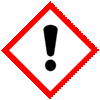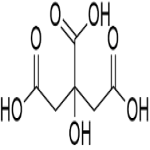Citric Acid Monohydrate Anhydrous SDS of Suppliers Exporters, Manufacturers
Citric Acid
CAS Number: 5949-29-1 & 77-92-9 Monohydrate Anhydrous BP Ph Eur USP FCC Reagent Food Grade Suppliers Exporters, Manufacturers
Please visit Main Page of Citric Acid Monohydrate Anhydrous BP Ph Eur USP FCC Reagent Food Grade Manufacturers.
Citric Acid SDS, Safety Data Sheet
MSDS Sheet 10-May-22
Section 1 - Chemical Product and Company Identification
Product Name & Other Names: Citric Acid or 2-Hydroxy-1,2,3-propanetricarboxylic acid
CAS#: 77-92-9 for anhydrous and 5949-29-1 for monohydrate.
EINECS EC Number: 201-069-1
Relevant uses and uses advised against (if any): Oil well fracturing and Industrial use.
Supplier: As per letterhead.
Section 2 - Hazards Identification
GHS, Globally Harmonized System Classification in accordance with 29 CFR 1910
Classification according to Regulation (EC) No 1272/2008
Acute toxicity, Dermal (Category 5)
Skin irritation (Category 3)
Eye irritation (Category 2A)
Labeling according to GHS USA & Regulation (EC) No 1272/2008
GHS Label Elements  Irritant |
Signal Words: Warning
Hazard statements:
H313: May be harmful in contact with skin.
H316: Causes mild skin irritation
H319: Causes serious eye irritation.
Precautionary statements:
P262: Do not get in eyes, on skin, or on clothing.
P264: Wash skin thoroughly after handling.
P280: Wear protective gloves/protective clothing/eye protection/face protection.
P270: Do not eat, drink or smoke when using this product.
P273: Avoid release to the environment.
P312: Call a POISON CENTER or doctor/physician if you feel unwell.
P332+313: If skin irritation occurs: Get medical advice/attention.
P302+P352: IF ON SKIN: Wash with plenty of soap and water.
P305+P351+P338: IF IN EYES: Rinse cautiously with water for several minutes. Remove contact lenses, if present and easy to do. Continue rinsing.
P337+P313 If eye irritation persists: Get medical advice/ attention.
Section 3 - Composition, Information on Ingredients
Product Name & Other Names: Citric Acid or 2-Hydroxy-1,2,3-propanetricarboxylic acid
CAS#: 77-92-9 for anhydrous and 5949-29-1 for monohydrate.
EINECS EC Number: 201-069-1
Section 4 - First Aid Measures
Always seek medical attention after first aid measures are provided.
Eyes: Immediately flush eyes with plenty of water for at least 15 minutes, occasionally lifting the upper and lower eyelids. Get medical aid. Do NOT allow victim to rub or keep eyes closed.
Skin: Flush skin with plenty of soap and water for at least 15 minutes while removing contaminated clothing and shoes. Get medical aid if irritation develops or persists.
Ingestion: Do NOT induce vomiting. If victim is conscious and alert, give 2-4 cupful of milk or water. Never give anything by mouth to an unconscious person. Get medical aid.
Inhalation: Remove from exposure to fresh air immediately. If breathing is difficult, give oxygen. Get medical aid. Do NOT use mouth-to-mouth resuscitation. If breathing has ceased apply artificial respiration using oxygen and a suitable mechanical device such as a bag and a mask.
Notes to Physician: Treat symptomatically and supportively.
Section 5 - Fire Fighting Measures
General Information: As in any fire, wear a self-contained breathing apparatus in pressure-demand, MSHA/NIOSH (approved or equivalent), and full protective gear. During a fire, irritating and highly toxic gases may be generated by thermal decomposition or combustion.
Extinguishing Media: Use water spray, dry chemical, carbon dioxide, or chemical foam. Use agent most appropriate to extinguish fire. Do NOT get water inside containers.
Suitable extinguishing media: Water, Foam, Carbon dioxide (CO2), Dry powder. No limitation of extinguishing media is specified.
Fire Fighting: In the event of fire, wear self-contained breathing apparatus. Prevent fire extinguishing water from contaminating surface water or the ground water system.
Extinguishing Media Not recommended: Avoid using solid water jet as it may scatter the fire.
Special Information: In the event of a fire, wear full protective clothing and NIOSH-approved self-contained breathing apparatus with full face piece operated in the pressure demand or other positive pressure mode. At elevated temperatures under fire conditions, it may produce toxic or irritating fumes. Fire-extinguishing work is done from the windward and the suitable fire-extinguishing method according to the surrounding situation is used. Uninvolved persons should evacuate to a safe place.
Section 6 - Accidental Release Measures
Personal precautions, protective equipment, and emergency procedures: Ventilate area of leak or spill. Avoid breathing dust/fumes/gas/mist/vapors/spray. Use individual protective equipment (waterproof boots, suitable protective clothing, safety glasses, etc.). Do not approach facing the wind.
Environmental precautions: Do not let the product enter drains, soil, or water sources.
Methods and materials used for containment cleanup procedures and Storage: Contain spilled material. Cover with an inert, non-combustible absorbent material, (e.g., sand, earth, diatomaceous earth, vermiculite). Vacuum or sweep-up and remove to an approved disposal container. Finish cleaning by spreading water on the contaminated surface and allow to evacuate as per law. Eliminate all ignition sources. Spill of Citric acid may be neutralized with lime.
Section 7 - Handling and Storage
Precautions for safe handling: Apply according to good manufacturing and industrial hygiene practices. Ensure proper ventilation.In case of insufficient ventilation, wear suitable respiratory equipment. Wash thoroughly after handling. Do not drink, eat, or smoke while handling. Avoid contact with skin, eyes, and clothing. Minimize dust generation. Avoid breathing dust/fumes/gas/mist/vapors/spray. Use individual protective equipment (waterproof boots, suitable protective clothing, safety glasses, etc.).
Conditions for safe storage, including any incompatibilities: Store in cool, dry, and ventilated area away from heat sources and protected from sunlight in tightly closed original container. Keep air contact to a minimum. Store protected from heat, sparks and ignition sources and incompatible materials. Do not store with incompatible materials like strong oxidizing agents, sulfides, metal nitrates, alkali carbonates, alkalis, potassium tartrate, acetates, bicarbonates. Store protected from moisture.
Section 8 - Exposure Controls, Personal Protection
Airborne Exposure Limits: None established.
Ventilation System: A system of local and/or general exhaust is recommended to keep employee exposures as low as possible.
Personal Respirators (NIOSH Approved): For conditions of use where exposure to dust or mist is apparent and engineering controls are not feasible, a particulate respirator (NIOSH type N95 or better filters) may be worn.
Skin Protection: Wear impervious protective clothing, including boots, gloves, lab coat, apron, or coveralls, as appropriate, to prevent skin contact.
Eye Protection: Use chemical safety goggles and/or full-face shield where dusting or splashing of solutions is possible. Maintain eye wash fountain and quick-drench facilities in work area of Citric acid.
Section 9 - Physical and Chemical Properties
Appearance: White crystals, granules or powder.
Odor: Odorless.
Odor threshold: Not applicable.
pH: 2.2 (0.1 N sol)
Relative density: around 1.54
Melting Point: ca. 100C (ca. 212F).
Initial boiling point and boiling range: No data found.
Flash point: No data found.
Auto-ignition temperature: No data found.
Decomposition temperature: No data found.
Upper/lower flammability or explosive limits: No data found.
Vapor pressure: No data found.
Vapor density: No data found.
Evaporation rate: No data found.
Flammability (solid, gas): No data found.
Partition coefficient: n-octanol/water: No data found.
Solubility: ca. 60 g/100 ml @ 20C (Anhydrous)
Viscosity: No data found.
Molecular Weight: 192.13 for anhydrous and 210.14 for monohydrate.
Chemical Formula: C6H8O7 for anhydrous and C6H8O7-H2O for monohydrate.
Section 10 - Stability and Reactivity
Chemical Stability: Stable under normal temperatures and pressures.
Conditions to Avoid: Incompatible materials, dust generation, moisture, exposure to moist air or water.
Incompatibilities with Other Materials: Oxidizing agents, sulfides (inorganic, e.g. ferric sulfide, lead sulfide, sodium sulfide), metal nitrates, alkali carbonates, alkalis, potassium tartrate, acetates, bicarbonates.
Hazardous Decomposition Products: Carbon monoxide, irritating and toxic fumes and gases, carbon dioxide.
Hazardous Polymerization: Will not occur.
Section 11 - Toxicological Information
Oral rat LD50: 3 gm/kg; Irritation skin rabbit: 500 mg/24H mild; Eye rabbit: 750 µg/24H severe.
Carcinogenicity: No component of this product present at levels greater than or equal to 0.1% is identified as probable, possible or confirmed human carcinogen by IARC, ACGIH, OSHA and NTP.
Mutagenic Effects: No data found.
Teratogenic Effects: No data found.
Developmental Toxicity: No data found.
Reproductive Effects: No data found.
Section 12 - Ecological Information
Toxicity to fish LC50 Leuciscus idus (Golden orfe): 440 - 760 mg/l; 96 h.
Toxicity to daphnia and other aquatic invertebrates: EC50 Daphnia magna (Water flea): ca. 120 mg/l; 72 h.
Persistence and Degradability: It is water soluble and unlikely to persist.
Mobility: It is water soluble and mobile.
Bioaccumulation/ Accumulation: Will not bioaccumulate.
Results of PBT and vPvB assessment: No data found.
Section 13 - Disposal Considerations
Whatever cannot be saved for recovery or recycling should be managed in an appropriate and approved waste disposal facility.
Section 14 - Transport Information
DOT USA & TDG Canada: Not controlled.
ADR/RID Europe: Not controlled.
IMO/IMDG: Not controlled.
ICAO/IATA: Not controlled.
Section 15 - Regulatory Information
USA:
SARA 311/312: See section 2.
Section 16 - Additional Information
DISCLAIMER: The information and recommendations set forth herein are presented in good faith and believed correct as of the date hereof. It is compiled from various sources, and it is not necessarily all inclusive nor fully adequate in every circumstance. In addition, these suggestions should not be confused with nor followed in violation of applicable laws, regulations, rules, or insurance requirements applicable. This MSDS sheet is intended only as a guide to the appropriate precautionary handling of the material by a professionally trained person using this product. Individuals receiving the information must exercise their independent judgment in determining its appropriateness for a particular purpose.

Please visit Technical Data Sheet of Citric Acid Monohydrate Anhydrous BP Ph Eur USP FCC Reagent Food Grade Suppliers.
Citric Acid CAS Number 5949-29-1 & 77-92-9 & Sodium Citrate CAS Number 68-04-2 or 6132-04-3 Supplier Exporter, Manufacturer:
Annie Chemie P Ltd
Mumbai 4000010, INDIA
With Agents and offices in UAE, USA, Europe.
e-mail: info@anniechemie.com
Copyright and Usual Disclaimer is Applicable.
May 31, 2025
Exporters to USA, Canada, UK, Europe, UAE, Nigeria, Algeria, Turkey, Mexico, Brazil, Chile, Argentina, Australia, Dubai etc.
Perfection is made up of small things and that is a big thing.
